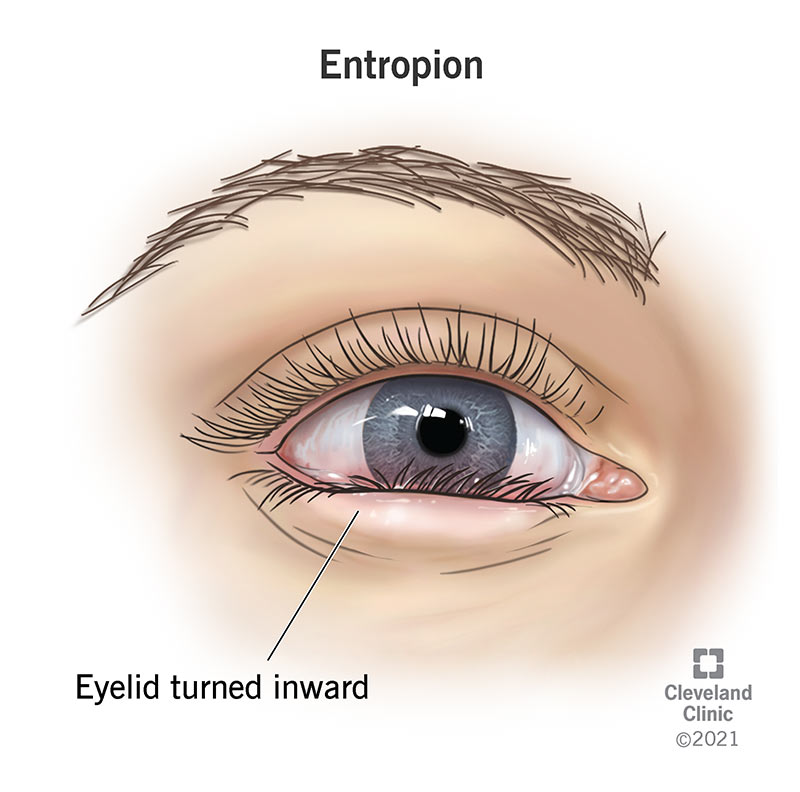Entropion is a condition where your eyelid turns in toward your eye. As a result, your eyelashes and skin rub against your eyeball, causing discomfort to your cornea (the front part of your eye). Entropion is common in adults over the age of 60. You can treat it in several ways, including soft contact lenses, Botox® injections or surgery.
Advertisement
Cleveland Clinic is a non-profit academic medical center. Advertising on our site helps support our mission. We do not endorse non-Cleveland Clinic products or services. Policy

Entropion is a condition that occurs when your eyelid turns inward toward your eyeball. When this happens, your eyelid skin and eyelashes rub against the surface of your eye. This friction often causes discomfort and irritation to your cornea (front of your eye). Entropion is the opposite of ectropion, the outward turning of your eyelid.
Advertisement
Cleveland Clinic is a non-profit academic medical center. Advertising on our site helps support our mission. We do not endorse non-Cleveland Clinic products or services. Policy
Entropion usually occurs in your lower eyelid, and it can happen on one side or both (bilateral entropion). Without treatment, it can damage your cornea and lead to vision loss. If you’ve developed the condition, it’s important to see an eye care specialist for treatment. Entropion treatment typically starts with noninvasive measures but may require surgery.
There are several types of entropion that can affect your eyes. These are:
Entropion causes many uncomfortable symptoms in your eye, including:
Advertisement
When you first develop entropion, you may only notice occasional symptoms. But over time, the symptoms usually become constant.
There are three characteristics of an eyelid with entropion: eyelid looseness (laxity), eyelid retractor disinsertion and excessively strong eyelid closing muscles which cause your eyelid to turn in rather than out. Lower eyelid laxity is common in people over the age of 60 because their eyelid supports weaken with age. Other causes of an in-turned eyelid include:
Aging is the biggest risk factor for entropion. It’s most common in people over 60 years old. According to the American Academy of Ophthalmology, it affects about 2.1% of people over the age of 60.
People with sleep apnea may be at greater risk of developing entropion, as they tend to have excessively loose upper eyelids (floppy eyelid syndrome), which are prone to turning in on themselves.
Entropion also affects women more often than men.
Your eye care specialist will start by asking you about your symptoms and medical history. They’ll perform an eye exam, looking for any signs of skin irritation, infection or scarring. They’ll pay close attention to the edges of your eyelid, as there are other medical conditions that can mimic entropion. They want to ensure they make the correct diagnosis to decide the proper treatment.
Your provider may perform several tests to help diagnose entropion. These tests include:
Your healthcare provider may treat entropion in several ways. Common entropion treatments include:
Advertisement
If your eyelid is turned in due to chronic inflammation, your provider may order labs or perform a biopsy to investigate rarer causes, like ocular cicatricial pemphigoid or trachoma.
The above options may offer a temporary fix, but your healthcare provider will usually have to perform surgery to address the inward-turning eyelid and return it to a normal position. These surgeries typically involve sedation and local anesthesia to numb your eyelid. You’ll go home the same day as your surgery.
Surgical entropion repair methods include:
While nonsurgical treatments are helpful in the short term, entropion surgery is usually necessary to fully and permanently correct the condition.
Advertisement
Most people experience temporary side effects following entropion surgery, including swelling and bruising. These symptoms are a normal part of healing and you can manage them with prescribed medication and cold compresses. In most cases, people fully recover from surgical entropion repair in about two weeks.
Contact your healthcare provider if your eyelid turns inward. Even if your eyelid doesn’t appear to turn inward, seek medical treatment if you feel like something is constantly in your eye.
If you have entropion, you may want to ask your healthcare provider:
Most people who receive treatment for entropion before it causes eye damage have a good outcome. Entropion surgery usually resolves the problem, and the condition rarely returns.
It’s important to treat entropion to avoid complications that may become permanent. Complications associated with an inward-turning eyelid include:
Because entropion often occurs naturally with aging or after scarring, it’s difficult to prevent. To reduce your risk of developing entropion caused by injury, wear protective eyewear during activities that could injure your eye.
Advertisement
If you feel like you always have something in your eye, or you notice your eyelashes are turning inward, it could be entropion. It’s important to correct the problem to avoid long-term issues like corneal injury and vision loss. Talk to your healthcare provider about your treatment options so you can improve your comfort, eye health and overall quality of life.
Getting an annual eye exam at Cleveland Clinic can help you catch vision problems early and keep your eyes healthy for years to come.

Last reviewed on 01/12/2025.
Learn more about the Health Library and our editorial process.